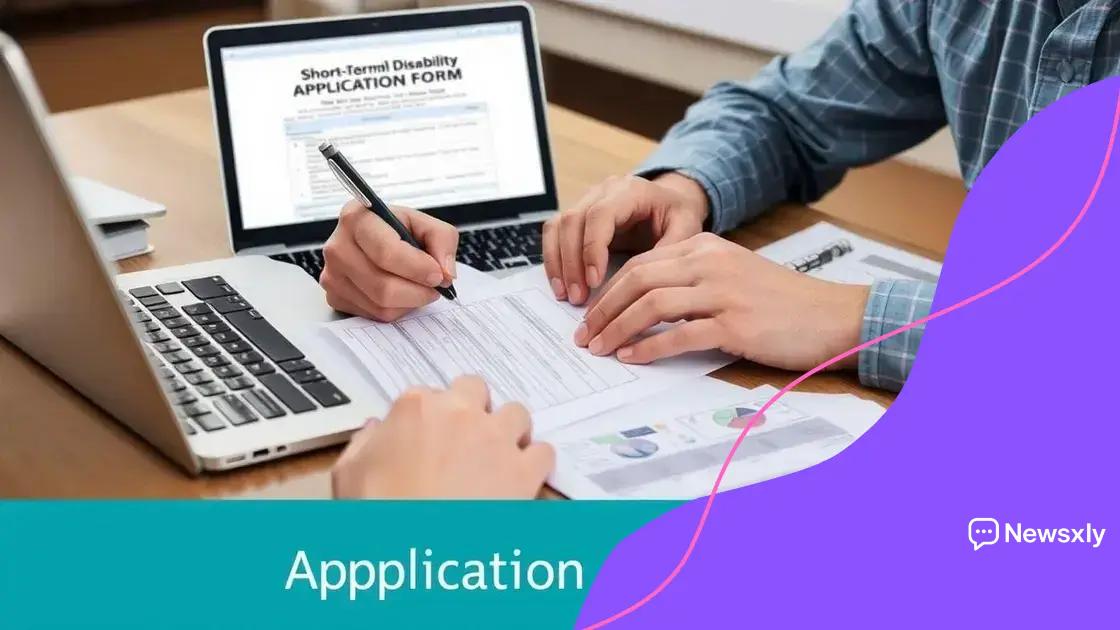Understanding short-term disability benefits: what you need to know

Understanding short-term disability benefits involves knowing eligibility criteria, the application process, the duration of benefits, and dispelling common misconceptions to ensure financial support during recovery from temporary medical conditions.
Understanding short-term disability benefits can feel overwhelming at first. However, knowing exactly how these benefits work can really come in handy when life throws curveballs your way.
What are short-term disability benefits?
Short-term disability benefits provide crucial financial support when you cannot work due to a temporary illness or injury. These benefits can significantly ease the burden during challenging times.
In general, short-term disability benefits replace a portion of your income, typically between 50% to 70%, while you recover. Understanding what these benefits entail is essential for making informed decisions about your coverage.
Key Features of Short-Term Disability Benefits
Many employers offer short-term disability benefits as part of their benefits package. However, eligibility and the specifics can vary widely. Here are some important aspects to consider:
- The benefits usually last from a few weeks up to six months.
- Coverage might begin following a waiting period, which can range from a few days to several weeks.
- Some policies include coverage for various types of medical conditions, including maternity leave.
Understanding the specifics of your policy is vital. You’ll want to know how long the benefits last and what circumstances are covered. Keep in mind that short-term disability benefits are different from long-term disability benefits, which generally kick in after the short-term coverage ends.
How Do Short-Term Disability Benefits Work?
To utilize these benefits, you typically need to provide documentation of your medical condition. This often includes a letter from your doctor confirming your inability to work. Some companies might require that you meet specific criteria before you can qualify.
Also, it’s essential to file your claim as soon as possible. Delays can lead to complications in receiving your benefits on time. Many employers have streamlined the process to enhance your experience.
Employers may partner with insurance companies to manage claims, ensuring you receive prompt and accurate payments. You can consult your human resources department for assistance in navigating the claims process and understanding your rights.
In summary, short-term disability benefits play a critical role in safeguarding your income during difficult times. By being proactive about your understanding of these benefits, you can protect yourself and your finances in case of unexpected events.
Eligibility criteria for short-term disability
Understanding the eligibility criteria for short-term disability is crucial for accessing the benefits you may need during a difficult time. Each employer may have different requirements, but there are common factors to consider.
Generally, to be eligible for these benefits, you must be a full-time employee who has completed a specified waiting period. This waiting period can vary and might range from one week to a month.
Common Eligibility Requirements
Here are some typical requirements that you might encounter when applying for short-term disability benefits:
- You must have a valid medical condition that prevents you from working.
- Your employer may require a minimum duration of employment before you can apply.
- Documentation from a healthcare provider is usually necessary.
Furthermore, some policies may not cover specific conditions, like work-related injuries or pre-existing conditions diagnosed before your coverage starts. It’s important to thoroughly read your policy documentation to understand what conditions are covered.
Many insurance providers will require you to provide proof of your condition through medical records or a doctor’s note. Ensuring that this documentation is accurate and submitted promptly can help streamline the claims process.
Employee Rights and Responsibilities
As an employee, you have the right to receive information about your coverage and any related policies. It’s essential to communicate with your human resources department if you have any questions about your eligibility.
Filing a claim for short-term disability benefits typically involves filling out specific forms and providing the necessary documentation. Be sure to keep a copy of everything you submit for your records.
How to apply for short-term disability benefits

Applying for short-term disability benefits can seem daunting, but breaking it down into clear steps makes the process manageable. Understanding how to navigate the application can help ensure you receive the support you need.
Typically, the first step in the application process is to gather the necessary documentation. This often includes medical records and a letter from your healthcare provider that details your condition and how it affects your ability to work.
Steps to Apply for Short-Term Disability Benefits
Here’s a quick overview of the steps you should follow:
- Review Your Policy: Begin by understanding the specifics of your employer’s short-term disability policy.
- Contact Human Resources: Reach out to your HR department for guidance on the application process and the forms you need to complete.
- Fill Out Required Forms: Carefully fill out all necessary paperwork, providing accurate information about your medical condition and employment.
- Submit Documentation: Along with your forms, make sure to submit any required medical documentation to support your claim.
After submitting your application, it’s crucial to monitor your claim’s progress. Keep a record of all communications with your employer or insurance provider. If there are delays or additional information is requested, respond promptly to avoid hindering your application.
Helpful Tips for a Successful Application
To enhance your chances of approval, consider these tips:
- Stay organized and keep copies of everything you submit.
- Be clear and concise when explaining your condition and its impact on your work.
- If necessary, seek assistance from your healthcare provider to ensure that your medical documentation is thorough and supportive.
Remember, applying for short-term disability benefits is your right as an employee. Being well-prepared and informed about the process can pave the way for a smoother experience when seeking the assistance you deserve.
Common misconceptions about short-term disability
When it comes to short-term disability, many people hold misconceptions that can lead to confusion and stress. Understanding the truth behind these myths is essential to effectively navigate the benefits available to you.
One common misconception is that short-term disability benefits are only available for severe medical conditions. In reality, these benefits can cover a variety of situations, including temporary illnesses, surgeries, and even maternity leave.
Misperceptions About the Application Process
Another myth is that applying for short-term disability is too complicated and burdensome. While the process does require documentation, most companies provide detailed guidance to help employees through it. Being organized can make it much easier.
- Many employers offer support through the HR department.
- Your healthcare provider can assist in providing necessary documentation.
- It’s important to submit your claim promptly to avoid delays.
Some people believe that if they have short-term disability benefits, their employer might hold it against them. This is not true; employers are typically not allowed to discriminate against employees who need to utilize these benefits. Your job protection remains intact during your recovery.
Understanding Coverage Limits
A frequent misunderstanding is regarding the duration of coverage. Some believe that if they are approved, they will receive benefits indefinitely. However, most short-term disability policies have set limits, commonly ranging from a few weeks to six months.
Another point of confusion is regarding waiting periods. Many assume they will receive benefits immediately; however, most policies require a waiting period before benefits kick in. Knowing these details can prevent surprises.
Knowing the facts can help you make informed decisions. By debunking these common misconceptions, you can confidently navigate the world of short-term disability benefits and ensure you receive the support you deserve when you need it most.
Understanding the duration of short-term disability
Understanding the duration of short-term disability benefits is essential for anyone considering this coverage. The length of time you can receive benefits typically depends on your employer’s policy and the specifics of your condition.
Most short-term disability policies provide coverage for a set period, usually ranging from a few weeks up to six months. It’s important to know that this duration is not the same for everyone and can vary based on individual circumstances.
Factors Affecting Duration
Several factors can influence how long you will receive short-term disability benefits:
- Your employer’s policy: Each employer may have different terms in their disability policy.
- The nature of your medical condition: Some conditions may require longer recovery times than others.
- Medical assessments: Insurance providers may require regular medical check-ups to determine your ongoing eligibility.
During your recovery, monitoring your health and maintaining communication with both your healthcare provider and your employer is vital. Keeping thorough documentation can also help when it comes to extending your benefits if your recovery takes longer than expected.
Waiting Periods
Another important aspect to consider is the waiting period before benefits start. This period can range from a few days to a couple of weeks, depending on your employer’s policy. Knowing this can help you plan better financially as you navigate your recovery.
By understanding the potential duration and limits of short-term disability benefits, you can make more informed decisions and ensure you are financially prepared during your recovery period. It is always advisable to read your specific policy details and discuss any concerns with your HR department or an insurance advisor.
In conclusion, understanding short-term disability benefits is key to securing your financial well-being during tough times. By knowing the eligibility criteria, application process, and duration of benefits, you can confidently navigate this vital aspect of your employment. Always remember to communicate with your HR department and keep detailed records of your medical conditions and claims. By staying informed and proactive, you will be better prepared to take advantage of these important benefits when you need them the most.
FAQ – Frequently Asked Questions about Short-Term Disability Benefits
What qualifies me for short-term disability benefits?
To qualify, you must be a full-time employee with a medical condition that prevents you from working, along with meeting your employer’s eligibility criteria.
How do I apply for short-term disability benefits?
You can apply by contacting your HR department for the necessary forms and documentation, and then submitting your claim along with medical proof of your condition.
How long can I receive short-term disability benefits?
The duration of benefits varies by employer but usually ranges from a few weeks to six months, depending on your recovery needs and policy terms.
Are there waiting periods for receiving benefits?
Yes, most policies have a waiting period before benefits start. This can range from a few days to several weeks, so it is essential to check your specific policy.





